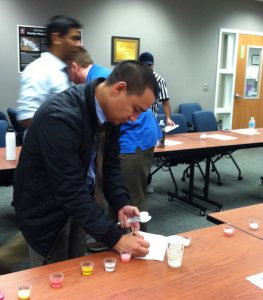Q: My 2-year old hates taking her medicine. Is there anything I can do to make it taste better?
Julie Andrews as the magical nanny Mary Poppins sang about how “a spoonful of sugar makes the medicine go down”. And to a child who doesn’t feel well, the bitter taste of a medicine is most unwelcome.
Have you ever muttered, “Do doctors have ANY IDEA how awful this stuff tastes?” On October 31st, sixteen new physicians learning how to be family doctors found out the answer to that question for themselves as they got a taste – literally – of their own medicine at the “Trick-Or-Treat Taste Test”.
These brave physicians-in-training, called residents, lined up to sample 10 different liquid medicines, half of which were commonly prescribed antibiotics. Each of the victims, er, participants lined up to collect their equipment and await their turn at sampling each liquid. To avoid creating a bottleneck, I set up two tables, each with an identical set of liquid samples awaiting judgment.
As each resident moved forward in line, they picked up a small paper cup containing 10 plastic spoons, a pencil and a score sheet listing each medicine in alphabetical order. To evaluate each sample, I instructed them to dip one of their clean plastic spoons into it, sniff it, and taste it, rating each one on the following characteristics: Smell, Taste, Texture, and Aftertaste. The scale was from 1 to 5, with a 5 standing for Extremely Good/Pleasant and a 1 representing Extremely Bad/Terrible.
I then pointed out to the two lines of neophyte judges the 2 double-lined trash containers positioned close to the sampling areas, each with 2-liter bottles of Sprite® and Fresca® standing next to a stack of paper cups. I carefully explained that they were supposed to taste each offering, but try to avoid swallowing it. The lined trash cans were there as spitoons and the Fresca® and Sprite® were available to help “cleanse their palate” after each sample. As a veteran of two previous taste tests, I assured them from vividly painful personal experience that although spitting wasn’t pleasant, it was significantly better than risking a world-class stomach ache.

As they sampled the liquids, some pink, some clear, I heard them ask each other, “How bad can it be?”… “Eeew, that’s just nasty”…“I always wondered how liquid antibiotics tasted, well, this is my chance to find out”… “YUK!”… “How can something that smells good taste so awful?”
There were 5 antibiotics chosen: amoxicillin, amoxicillin with clavulanate, cephalexin, sulfamethoxizole-trimethoprim, and azithromycin. These are all very common antibiotics given to children for ear and skin infections.
The 5 antibiotics chosen were: amoxicillin, amoxicillin with clavulanate, cephalexin, sulfamethoxizole-trimethoprim, and azithromycin. Prednisolone, which is given to children with asthma, and is notoriously bitter tasting, was also included. Young doctors often choose prednisone liquid, but as bitter as prednisolone tastes, prednisone tastes even WORSE. Having young doctors taste it themselves helps them remember why they should avoid prednisone and order prednisolone instead.
The other selections included potassium chloride, ranitidine, iron, and nystatin suspension. Potassium chloride liquid was chosen so that they could appreciate its saltiness, ranitidine was chosen because it is often used for stomach pain and burning in children, liquid iron supplementation was another selection, and that was another choice. Iron supplement as a liquid was also evaluated, and the final options was nystatin suspension, which is often used for thrush.

Each resident physician evaluated the 10 samples on a scale of 1 to 5, from 1 being Extremely Bad/Terrible to 3 as Neutral and 5 being Extremely Good/Pleasant. Each sample was rated for its smell, taste, texture and aftertaste.
The winner overall was amoxicillin, and the worst overall was potassium chloride. There was a tie for WORST TASTE between prednisolone and potassium chloride. Potassium chloride took “top honors” for WORST SMELL. The entry that was voted WORST TEXTURE was azithromycin and WORST AFTERTASTE was prednisolone.
As the votes were being tallied, we brainstormed on ways to minimize the terrible taste of medicines. One strategy was to mix it into something else that could mask the smell, taste or texture. Since most liquid medicines can be given with food, they suggested pudding, applesauce, or ice cream as good choices to hide the taste. Another idea was following the medicine with a “chaser” that rinsed the liquid off the taste buds quickly. The taste test judges overwhelmingly preferred the grapefruit flavored Fresca® for this purpose over the lemon-lime flavor of Sprite®.
Another option suggested was chocolate syrup, either by itself or mixed into pudding or ice cream. Chilling the medicine by placing it into the refrigerator was another approach, as was adding flavoring to the entire bottle of medicine. Small amounts of flavored extract used to flavor candy are available at some groceries and kitchen supply stores, or you could use concentrates sold to flavor water, like Crystal Light® or MiO®. Some pharmacies will add flavoring to liquid medicines, if you request it. Because flavors depend on scent receptors found in the lining of your nose, an older child could hold his nose while swallowing and quickly follow it with a swallow of another liquid to remove the taste.
Dr. Louise Achey, Doctor of Pharmacy is a 30-year veteran of pharmacology. Please send your questions and comments to www.AskDrLouise.com.


Just had to literally fight my 4 yo to take prednisone suspension. I tasted it and
I could see why. After trying it in applesauce, I could still taste the bitter aftertaste even after 4 cookies and a glass of milk. Yuck.